
Tradescantia virginiana, the Virginia spiderwort, is a species of flowering plant in the family Commelinaceae. It is the type species of the genus Tradescantia, native to the eastern United States. Common names include Virginia spiderwort, common spiderwort, lady’s tears, and spider lily.
Erysimum teretifolium is a species of Erysimum known by the common names Santa Cruz wallflower and Ben Lomond wallflower. It is a very rare plant endemic to Santa Cruz County, California, where it grows on inland sand spits, chaparral, and sandstone deposits in the southern Santa Cruz Mountains. It is a California state and federally listed endangered species.

Abronia alpina is a rare species of flowering plant in the four o'clock family known by the common names Ramshaw Meadows sand verbena and Ramshaw Meadows abronia. It is endemic to Tulare County, California, where it is known from only one area high in the Sierra Nevada.
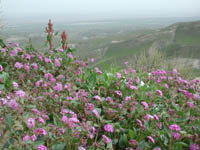
Abronia pogonantha is a species of flowering plant in the four o'clock family (Nyctaginaceae) known by the common name Mojave sand-verbena. It is native to California and Nevada, where it grows in the Mojave Desert, adjacent hills and mountains, and parts of the San Joaquin Valley in the Central Valley.

Ambrosia chamissonis is a species of ragweed known by the common names silver burr ragweed, silver beachweed and (silver) beach bur(r).
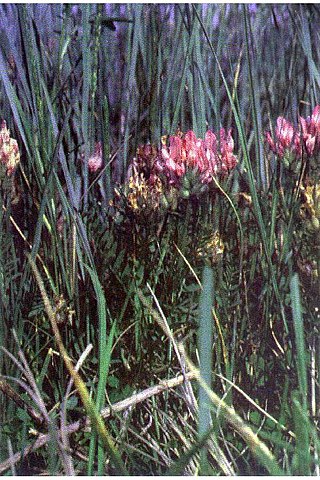
Astragalus agrestis is a species of milkvetch known by the common names purple milkvetch, purple loco, and field milkvetch. It is native to much of western and northern North America from most of Canada to the southwestern United States, as well as eastern Asia. It grows in vernally moist areas such as meadows, and is often found in sagebrush.
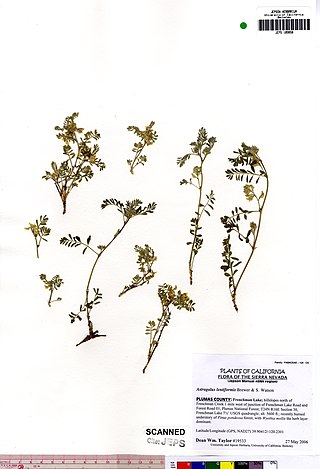
Astragalus lentiformis is a species of milkvetch known by the common name lens-pod milkvetch. It is endemic to the Sierra Nevada in eastern Plumas County, California, where it grows in chaparral scrub and coniferous forests.
Chorizanthe rectispina is a species of flowering plant in the buckwheat family known by the common names prickly spineflower and straight-awned spineflower. It is endemic to California, where it is known from about twenty occurrences from Monterey to Santa Barbara Counties. It grows in dry habitat types such as chaparral and woodland in the hills of the Central Coast Ranges. It is a low, spreading plant with stems up to about 25 centimeters long, grayish to greenish in color and hairy in texture. The inflorescence is a cluster of flowers, each flower surrounded by six hairy bracts which are grayish to pink in color and tipped with awns. One bract is longer than the others and has a straight awn, and the other smaller bracts may have hooked awns. The tiny flower at the center of the bract array is a few millimeters wide and white and yellow in color.

Cirsium crassicaule is a species of thistle known by the common name slough thistle. It is endemic to the San Joaquin Valley of California, where it is known primarily from freshwater wetlands. It has been found in only a few locations in Kern, Kings, and San Joaquin Counties.

Cirsium mohavense is a species of thistle known by the common names virgin thistle and Mojave thistle. It is native to the southwestern United States, where it grows in moist areas in otherwise dry habitat, such as desert springs. It is most common in the Mojave Desert, found also in the southern Great Basin and other nearby regions of California, Nevada, western Arizona, and southwestern Utah.

Abronia mellifera, the white sand verbena, is a herbaceous perennial flowering plant in the Nyctaginaceae family. It is endemic to the northwestern United States.

Abronia fragrans, the sweet sand-verbena, snowball sand-verbena, prairie snowball or fragrant verbena, is a species of sand verbena.

Lupinus brevicaulis is a species of lupine known by the common names shortstem lupine and sand lupine. It is native to the southwestern United States, including Oregon, California, Nevada, Utah, Colorado, Arizona, and New Mexico, where it grows in many types of sandy habitat.
Madia anomala is a species of flowering plant in the family Asteraceae known by the common name plumpseeded madia. It is endemic to northern California, where it can be found on hillsides in the San Francisco Bay Area and adjacent mountains and valleys.

Madia sativa, known by the common names coast tarweed and Chilean tarweed, is a species of flowering plant in the family Asteraceae found in parts of western North and South America.
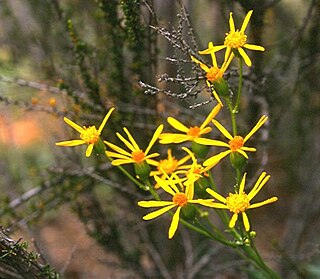
Packera layneae, known by the common name Layne's ragwort and Layne's butterweed, is a rare species of flowering plant in the aster family.
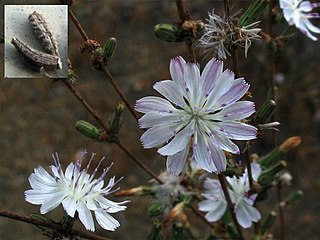
Stephanomeria diegensis is a species of flowering plant in the family Asteraceae known by the common name San Diego wirelettuce. It is native to the coastal hills and ranges of southern California and Baja California, where it grows in many types of open habitat. It evolved as a hybrid of Stephanomeria exigua and S. virgata. Furthermore, it is thought to be the result of homoploid hybrid speciation, which is uncommon. The plant is frequently misidentified as one of its parents, especially if older taxonomic keys are used. This is an erect annual herb easily exceeding two meters in height. Its slender stem has many spreading branches. The basal leaves are linear to lance-shaped and up to 10 centimeters long. The leaves wither early and are absent for most of the year, giving the plant a twiglike appearance. Leaves on the upper stem are small and reduced. The inflorescences are usually clusters of flower heads located at intervals on the stiff branches. Each head has a cylindrical base lined with phyllaries. These are often glandular. The head contains several ray florets, each with an elongated tube and a white or pink-tinged ligule measuring around a centimeter long. The fruit is a grooved achene tipped with a spreading cluster of long, plumelike pappus bristles.

Viola douglasii is a species of violet known by the common name Douglas' violet, or Douglas' golden violet. It is native to western North America from Oregon through California and into Baja California, where it grows in seasonally moist habitat, often on serpentine soils. This rhizomatous herb produces a cluster of erect stems just a few centimeters in length to about 20 centimeters in maximum height. The leaf blades are deeply dissected into several narrow lobes or compound, made up of leaflets, and borne on long petioles. They are hairless to softly hairy in texture. A solitary flower is borne on a long, upright stem. It has five bright or deep yellow petals with brown veining and brown outer surfaces. The largest lowest petal may be over 2 centimeters in length.

Abronia macrocarpa is a rare species of flowering plant known by the common name largefruit sand verbena. It is endemic to eastern Texas, where its current range is limited to Freestone, Leon, and Robertson counties. It inhabits harsh, open sand dunes on savannas, growing in deep, poor soils. It was first collected in 1968 and described as a new species in 1972. It is a federally listed endangered species of the United States.
Cyperus fauriei is a rare species of sedge known by the common name alpine flatsedge. It is endemic to Hawaii, where it grows on the islands of Molokai and Hawaii. It is a federally listed endangered species of the United States.
















